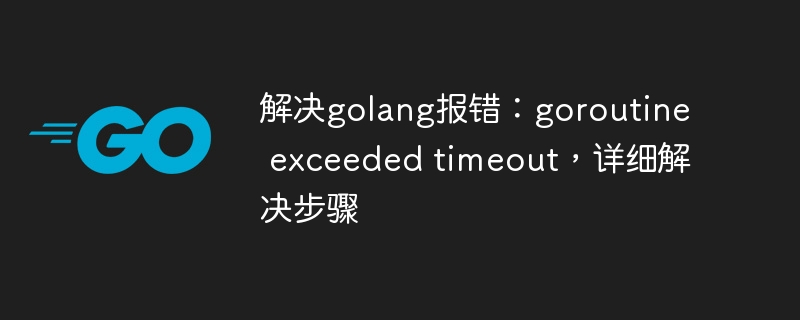解决golang报错:goroutine exceeded timeout,详细解决步骤

解决golang报错:goroutine exceeded timeout,详细解决步骤
引言:
在使用golang进行并发编程时,经常会遇到goroutine超时的问题。本文将详细讲解如何解决这个问题,并给出相应的代码示例。
问题背景:
在golang中,使用goroutine可以方便地实现并发编程。然而,有时候我们在使用goroutine时,会发现部分goroutine执行时间过长,超过了我们设定的超时时间,导致整个程序出现异常或者陷入等待状态。
解决步骤:
下面是解决golang报错:goroutine exceeded timeout的详细步骤。
步骤一:使用context包
context包是golang的一个标准包,用于传递请求的上下文信息,并控制goroutine的生命周期。我们可以创建一个带有超时时间的context,并将其传递给需要执行的goroutine。
首先,我们需要导入context包:
import (
"context"
"time"
)接下来,我们创建一个带有超时时间的context:
ctx, cancel := context.WithTimeout(context.Background(), 5*time.Second) defer cancel()
上述代码中,我们通过调用context.WithTimeout方法创建了一个超时时间为5秒的context。同时,我们使用defer语句来确保在函数返回前取消context的执行。
步骤二:使用select语句
在goroutine中,通过使用select语句,我们可以同时等待多个channel的返回结果,并设置超时时间。
在我们要进行goroutine调用的地方,我们使用select语句来等待结果:
select {
case <-ctx.Done():
fmt.Println("Goroutine timeout")
case result := <-ch:
fmt.Println("Result:", result)
}上述代码中,我们使用ctx.Done()接收超时信号,如果超时时间到达,我们会输出对应的提示信息。而如果goroutine正常返回结果,我们会通过channel来接收结果。
步骤三:超时处理
上述代码已经实现了超时的检测和处理,但是当超时发生时,并没有停止goroutine的执行。为了能够停止goroutine的执行,我们可以在goroutine内部进行判断,并在超时发生时返回相应的错误。
下面是一个示例代码,展示了如何在goroutine内部判断超时,并返回错误信息:
go func() {
select {
case <-ctx.Done():
fmt.Println("Goroutine timeout")
return
default:
// 执行goroutine的逻辑
// ...
}
}()上述代码中,在goroutine内部,我们使用select语句来等待超时信号。如果超时时间到达,我们将会输出对应的提示信息,并通过return语句返回,停止goroutine的执行。
完整示例代码:
下面是一个完整的示例代码,展示了如何解决golang报错:goroutine exceeded timeout的问题。
package main
import (
"context"
"fmt"
"time"
)
func main() {
ctx, cancel := context.WithTimeout(context.Background(), 5*time.Second)
defer cancel()
ch := make(chan string)
go func() {
select {
case <-ctx.Done():
fmt.Println("Goroutine timeout")
return
default:
time.Sleep(10 * time.Second)
ch <- "Done"
}
}()
select {
case <-ctx.Done():
fmt.Println("Goroutine timeout")
case result := <-ch:
fmt.Println("Result:", result)
}
}总结:
通过使用context包和select语句,我们可以方便地解决golang报错:goroutine exceeded timeout的问题。在并发编程中,合理设置超时时间并对超时进行处理,可以避免程序发生异常和长时间等待的情况。希望本文能够对解决goroutine超时问题的方法有所帮助。
以上是解决golang报错:goroutine exceeded timeout,详细解决步骤的详细内容。更多信息请关注PHP中文网其他相关文章!

热AI工具

Undresser.AI Undress
人工智能驱动的应用程序,用于创建逼真的裸体照片

AI Clothes Remover
用于从照片中去除衣服的在线人工智能工具。

Undress AI Tool
免费脱衣服图片

Clothoff.io
AI脱衣机

AI Hentai Generator
免费生成ai无尽的。

热门文章

热工具

记事本++7.3.1
好用且免费的代码编辑器

SublimeText3汉化版
中文版,非常好用

禅工作室 13.0.1
功能强大的PHP集成开发环境

Dreamweaver CS6
视觉化网页开发工具

SublimeText3 Mac版
神级代码编辑软件(SublimeText3)

热门话题
 如何使用 Golang 安全地读取和写入文件?
Jun 06, 2024 pm 05:14 PM
如何使用 Golang 安全地读取和写入文件?
Jun 06, 2024 pm 05:14 PM
在Go中安全地读取和写入文件至关重要。指南包括:检查文件权限使用defer关闭文件验证文件路径使用上下文超时遵循这些准则可确保数据的安全性和应用程序的健壮性。
 如何为 Golang 数据库连接配置连接池?
Jun 06, 2024 am 11:21 AM
如何为 Golang 数据库连接配置连接池?
Jun 06, 2024 am 11:21 AM
如何为Go数据库连接配置连接池?使用database/sql包中的DB类型创建数据库连接;设置MaxOpenConns以控制最大并发连接数;设置MaxIdleConns以设定最大空闲连接数;设置ConnMaxLifetime以控制连接的最大生命周期。
 如何在 Golang 中将 JSON 数据保存到数据库中?
Jun 06, 2024 am 11:24 AM
如何在 Golang 中将 JSON 数据保存到数据库中?
Jun 06, 2024 am 11:24 AM
可以通过使用gjson库或json.Unmarshal函数将JSON数据保存到MySQL数据库中。gjson库提供了方便的方法来解析JSON字段,而json.Unmarshal函数需要一个目标类型指针来解组JSON数据。这两种方法都需要准备SQL语句和执行插入操作来将数据持久化到数据库中。
 Golang框架与Go框架:内部架构与外部特性对比
Jun 06, 2024 pm 12:37 PM
Golang框架与Go框架:内部架构与外部特性对比
Jun 06, 2024 pm 12:37 PM
GoLang框架与Go框架的区别体现在内部架构和外部特性上。GoLang框架基于Go标准库,扩展其功能,而Go框架由独立库组成,实现特定目的。GoLang框架更灵活,Go框架更容易上手。GoLang框架在性能上稍有优势,Go框架的可扩展性更高。案例:gin-gonic(Go框架)用于构建RESTAPI,而Echo(GoLang框架)用于构建Web应用程序。
 如何找出 Golang 正则表达式匹配的第一个子字符串?
Jun 06, 2024 am 10:51 AM
如何找出 Golang 正则表达式匹配的第一个子字符串?
Jun 06, 2024 am 10:51 AM
FindStringSubmatch函数可找出正则表达式匹配的第一个子字符串:该函数返回包含匹配子字符串的切片,第一个元素为整个匹配字符串,后续元素为各个子字符串。代码示例:regexp.FindStringSubmatch(text,pattern)返回匹配子字符串的切片。实战案例:可用于匹配电子邮件地址中的域名,例如:email:="user@example.com",pattern:=@([^\s]+)$获取域名match[1]。
 从前端转型后端开发,学习Java还是Golang更有前景?
Apr 02, 2025 am 09:12 AM
从前端转型后端开发,学习Java还是Golang更有前景?
Apr 02, 2025 am 09:12 AM
后端学习路径:从前端转型到后端的探索之旅作为一名从前端开发转型的后端初学者,你已经有了nodejs的基础,...
 如何用 Golang 使用预定义时区?
Jun 06, 2024 pm 01:02 PM
如何用 Golang 使用预定义时区?
Jun 06, 2024 pm 01:02 PM
Go语言中使用预定义时区包括以下步骤:导入"time"包。通过LoadLocation函数加载特定时区。在创建Time对象、解析时间字符串等操作中使用已加载的时区,进行日期和时间转换。使用不同时区的日期进行比较,以说明预定义时区功能的应用。
 golang框架开发实战教程:常见疑问解答
Jun 06, 2024 am 11:02 AM
golang框架开发实战教程:常见疑问解答
Jun 06, 2024 am 11:02 AM
Go框架开发常见问题解答:框架选择:取决于应用需求和开发者偏好,如Gin(API)、Echo(可扩展)、Beego(ORM)、Iris(性能)。安装和使用:使用gomod命令安装,导入框架并使用。数据库交互:使用ORM库,如gorm,建立数据库连接和操作。身份验证和授权:使用会话管理和身份验证中间件,如gin-contrib/sessions。实战案例:使用Gin框架构建一个简单的博客API,提供POST、GET等功能。






